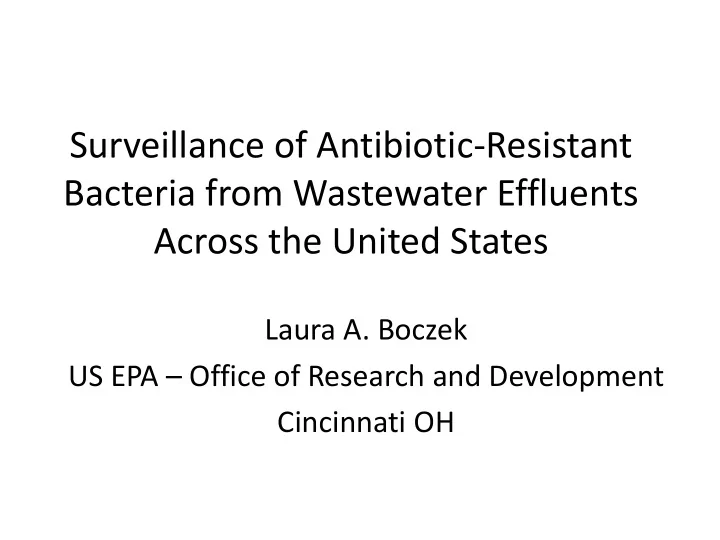

Surveillance of Antibiotic-Resistant Bacteria from Wastewater Effluents Across the United States Laura A. Boczek US EPA – Office of Research and Development Cincinnati OH
Background
Schematic of Wastewater Treatment
EPA Regulations that Govern Wastewater Treatment and Biosolid Land Application Clean Water Act (CWA) Enacted October 18, 1972 (PL 92-500)
EPA Wastewater and Biosolid Regulations • Clean Water Act (CWA) 1972 – Water quality standards for receiving waters based upon use and health and impact of aquatic and human life • National Pollutant Discharge Elimination System Permit Program (NPDES) • 40 CFR part 503 – Residuals management
Why Do We Treat and Regulate Wastewater? • The goal of disinfection is to kill or inactivate waterborne fecal indicators and pathogenic bacteria, viruses, parasites, etc. • The purpose of wastewater disinfection is to protect water quality and downstream uses – still linked to protecting public health – Supplement Potable Supplies – Recreation ● Crop Irrigation ● Fish Farming
2 Surveillance Studies • First Surveillance study conducted in 2003, focused on antibiotic-resistant E. coli related to uropathogenic infections from 7 geographically dispersed regions of the US • Further studied these organisms for presence of extended spectrum β -lactamase production (ESBL) • Second Study conducted 2013 focused on Carbapenem resistant E. coli from 7 geographically dispersed regions of the US
Findings of Research To Date • 1 st Study survey demonstrated E. coli resistant to common antibiotics (trimethoprim- sulfamethoxazole) for treatment of urinary tract infections was widespread across the US, and 92% of these isolates were also resistant to at least one other antibiotic • ESBL production was also present in nearly half of these isolates • 2 nd study carbapenem resistant E. coli are widespread in wastewaters in the US • 25% of antibiotic-resistant E. coli were CRE
Future Research • Determine if archived samples also confer resistance to carbapenem antibiotics • Examine biosolid residuals for presence of antibiotic-resistance profiles of emerging concern, CRE • Determine the disinfection efficacy related to these organisms, are they more resistant to commonly used wastewater and drinking water disinfectants, making them more resilient and resistant to treatment
Disclaimer The U.S. Environmental Protection Agency, through its Office of Research and Development, funded and managed, or partially funded and collaborated in, the research described herein. It has been subjected to the Agency’s peer and administrative review and has been approved for external publication. Any opinions expressed in this paper are those of the author (s) and do not necessarily reflect the views of the Agency, therefore, no official endorsement should be inferred. Any mention of trade names or commercial products does not constitute endorsement or recommendation for use.
Thanks For Your Attention! Laura Boczek US EPA / ORD / NRMRL 513-569-7282 boczek.laura@epa.gov
Recommend
More recommend